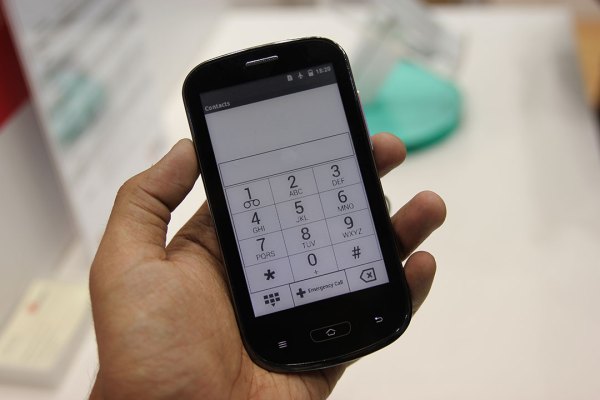It takes a lot to stand out at a trade show the size of Mobile World Congress. But here’s one device that caught my eye today: an e-ink smartphone. Unlike Yota Phone, the Russian startup that’s using e-ink as a second screen to augment the back of a powerful high end smartphone in a bid to stand out in the uber crowded Android space, this prototype device has just the one screen. A single e-ink screen on the front of the device — so it’s a true e-ink phone.
It’s also a
true smartphone. There were two prototypes on show at Eink‘s stand, both
with a 1GHz chip inside and one (the white one) with a 3G chip in it. The other
had Edge connectivity. The phones run Android but, as you’d expect, the OS has
been simplified with a custom UI that strips back the functionality to focus on
the applications that make sense for a fully e-ink smartphone — such as a
reader app, a dialer and email. The UI also includes a web browser since
certain types of webpages can be viewed on an e-ink screen. It won’t support
video of course but text-based sites can still be read.
The black
prototype device (pictured below) also includes a backlight for reading in the
dark. Both screens are capacitive, but as you’d expect with e-ink the refresh
rate can be a little slow. Ghosting on the screen from past renders can be
removed by shaking the device. The technology can support both portrait and
landscape orientation so the e-ink smartphone could be turned on its side to
switch the orientation to more of an e-reader sized width. Both devices felt
incredibly lightweight.
Why do you
want an only e-ink phone? Price for one thing. Battery life for another. Not to
mention visibility in bright sunlight. Put all those factors together and this
could be the perfect device for some emerging markets where electricity is at a
premium. The prototypes are proof of concept at this point but Giovanni
Mancini, director of product management for E-ink — the company which makes the
screen — said the Chinese OEM which has made the prototypes, Fndroid, is talking to
telcos and could launch a device this year.
So how much
would this e-ink smartphone cost? Mancini said the device maker would set the
price but in his view it would be comparable with a feature phone price tag. A
big theme of this year’s MWC has been smaller mobile players — from open source
OSes like Firefox that are seeking to drive openness and accessibility and
drive down the cost of devices, to mobile veterans like Nokia focusing afresh
on building smarter feature phones to target cost-conscious users in emerging
markets. So it’s interesting to see companies toying with the idea of an
entirely e-ink smartphone to cut device costs while preserving key smartphone
functions such as access to the internet and email. [TechCrunch]
You can follow me on Twitter, add me to your
circles on Google+ or Subscribe to
me on facebook or YouTube. You can also
check my website and blog to keep yourself
updated with what is happening in the ever changing world of technology







No comments:
Post a Comment